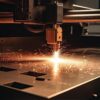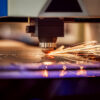The oil and gas industry operates in some of the harshest conditions imaginable. Components used in exploration, drilling, and refining must withstand extreme temperatures, corrosive environments, and immense pressures. Consequently, the materials, tolerances, and performance requirements for these parts are incredibly demanding. Laser turning offers distinct advantages to meet these challenges, becoming a powerful asset for oil and gas equipment manufacturers.
Why Laser Turning Excels in Oil & Gas Manufacturing
-
Wear-Resistant Materials: Oil and gas equipment often requires parts made from hard alloys, superalloys, and specialized ceramics. Laser turning effectively machines these materials where traditional cutting tools may wear down quickly or fail entirely.
-
Corrosion Resistance: Lasers excel at working with stainless steels, nickel alloys, and other corrosion-resistant materials essential for combating the harsh chemical environments in the oil and gas industry.
-
Complex Geometries: Downhole tools, valves, pumps, and other components often feature intricate shapes and internal channels. Laser turning achieves the necessary level of precision and detail.
-
Tight Tolerances: With the high pressures and extreme forces involved, precise tolerances are critical in oil and gas equipment. Laser turning delivers the necessary precision to ensure proper fit, sealing, and long-term reliability.
-
Reduced Lead Times: In an industry where downtime is costly, the speed of laser turning is crucial. Rapid prototyping and fast production cycles help keep operations running smoothly.
Key Applications of Laser Turning in Oil & Gas
- Drilling Components: Drill bits, downhole tools, wellhead components
- Flow Control: Valve bodies, nozzles, precision orifices
- Pump Components: Impellers, shafts, wear rings
- Subsea Equipment: Corrosion-resistant parts, complex sensor housings
- Refining Equipment: Heat exchanger components, cracking tubes
Beyond Performance: Additional Benefits
- Minimized HAZ: Reduced heat input during laser turning preserves the material properties and structural integrity crucial for high-pressure applications.
- Repeatable Accuracy: Laser turning ensures consistency across large production runs, crucial for maintaining quality and interchangeability of parts.
- Customization: Laser turning is flexible enough to accommodate design changes or the production of specialized parts for unique applications.
Choosing the Right Partner
Implementing laser turning for oil and gas components requires working with a manufacturing partner who possesses deep expertise in both laser technology and the stringent requirements of the industry. Look for a company that:
- Understands Material Challenges: Experience with the specific alloys and corrosion-resistant materials common in oil and gas is key.
- Meets Quality Standards: Look for certifications like ISO 9001:2015 that demonstrate a commitment to quality control.
- Offers Design Support: A partner who can collaborate on part design to optimize for laser turning will maximize advantages.
The Laser Advantage
In the demanding world of oil and gas, laser turning is more than just a manufacturing method. It’s a strategic tool for producing high-performance components that withstand the test of extreme conditions. By partnering with the right laser turning experts, manufacturers can enhance the durability, efficiency, and ultimately, the profitability of their operations.







